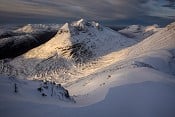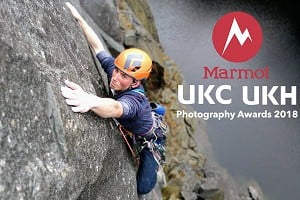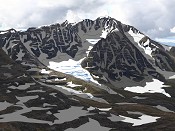
To bring originality to your landscape photography, look beyond the busy locations and seek out lesser-trodden viewpoints, says Feargus Cooney. Stepping off the beaten path is rewarding, but can have challenges too. Here's his advice for making the most of it safely.
Some iconic mountain locations in the UK have attracted photographers for decades. Sites such as the lonely tree of Llyn Padarn in Snowdonia, Tarn Hows in Cumbria, the River Etive below the Buachaille Etive Mor or the summit of Stac Pollaidh are so well known that they've become clichés. While these locations are fine for honing one's skills or guaranteeing a great composition, they are the low-hanging fruit of the field.

For me a much more rewarding experience lies in searching for unknown perspectives, capturing truly unique images that are off the mental map and won't be found in any photography guidebooks or websites, unbound by expectations of what one might hope to take home at the end of the day. As a bonus these excursions afford great opportunities to explore the landscape, and if one is prepared to go off the beaten path – to find places few people ever even visit, let alone photograph.
The basics - doing your research
You're looking for views almost no one has taken an interest in before, and that can be very rewarding
As with developing any skill, prior experience helps immensely before forging out into uncharted territory. Learning the basics and developing some skill in photography beforehand will help a lot if you are to develop a familiarity with the technical specifics of the camera, light, and spotting when the elements of composition are arranged in a winning combination. There are numerous guidebooks and web-based resources out there for beginners, and joining a local camera club or paying for tuition are other avenues which can be pursued to rapidly develop the basic skills.
With a little experience and the steep initial learning curve behind you, there are several ways to improve the chances of success when heading out into the hills for uncharted photo territory.
As with any trip, I start by looking at maps and aerial imagery. The Ordnance Survey Explore website is my preferred starting point. Here there is free access to topographic maps of the whole UK, as well as the best aerial imagery that I know of for getting an idea of the features on the ground. Pay for a subscription and you can access the full range of Landranger and Explorer mapping too. Google Earth can also be a help because of the ease with which you can change perspective to view an area from particular angles, visualising a landscape in advance.
Just as important as the wider landscape is the foreground, and this is often the tricky part to plan in advance because smaller features can be difficult to visualise in relief on a map or aerial image. Rivers or streams can be a good start because they often snake across the landscape, providing natural leading lines, while lakes or tarns can also make excellent foregrounds, especially if the weather is calm, producing reflections on the water surface. Trees, rocks and boulders can also be visually compelling, and in this case it's more a question of searching around for a pleasing arrangement once on location. Human elements in the landscape such as ruined buildings and bridges are also an option and are usually visible in aerial images.
Painting with light
The word photography literally means 'to draw with light', and lighting conditions make all the difference between having a simple record of the place you've found, and a really compelling image. In sunny conditions it pays to have a good idea in advance of which direction the light will be coming from at a given time of day. I use a relatively simple, low-cost app called 'LightTrac', which provides the angle of the sun at any particular time, as well as sunrise/set times for any given location. There are also various more expensive and complex apps available such as 'PhotoPills' and 'The Photographer's Ephemeris', which include features such as augmented reality for planning shoots, though I have not tested these personally.
the real joy comes from being creative and spending time in special places at their visual best
The other key element in terms of conditions is of course the weather, and depending on whether you are looking to capture a glorious scene in the golden light of the setting sun, a dramatic cloudscape engulfing the hills, or a snowscape, using the best weather forecasting resources that are available is essential practice. While I generally avoid bad weather days, many prize-winning images are caught in momentary glimpses of dramatic cloud formations and brief sunbursts between showers and storms. Being prepared and in position for those moments requires careful planning, whether shooting in colour or black and white.
With experience you will learn to read the landscape in terms of potential images, and when out and about may find you pick out distant spots that strike you as good locations for future visits. For example, two of the images I'm most proud of were both visualised in advance from the summit of Stac Pollaidh in northwest Scotland – itself a very popular site for photographers.
To the east I spotted a dramatic hanging corrie halfway up the western face of Cul Mor, containing a small loch. No trails led into this place, but when I ventured in there on a late summer's day I discovered some extremely photogenic spots on the sandy shore of the loch and the small stream which flowed into it. I returned on a snowy November day to shoot the scene bathed in the pink light reflected from the clouds after sunset.
The more remote peak of Suilven – which lies deep within the Inverpolly wilderness – is one of the most photographed mountains in northern Scotland, but it is usually captured from either the summit or from a distance by telephoto lens because of its remoteness. I wanted to shoot it from below the dramatic western end, which meant leaving the trails and crossing several kilometres of boggy ground for a midsummer sunset – when I knew the light would be just right to provide just a little shade on the southern face. I fortuitously came across a photogenic group of boulders for the foreground (which were far more visually interesting than the loch I had been intending to use) and was unexpectedly lucky to have some cloud bubbling off the summit and forming a tail drifting away in the wind.
The experience of photographing Suilven illustrates one of the most important aspects of wilderness photography – luck! Good planning can improve your chances dramatically, but some features which make an image really special are simply the result of being in the right place at the right time, and the more time you spend in the hills with a camera the more opportunities will present themselves. This especially applies to telephoto landscapes – which are harder to predict in advance – and small details such as rocks, moss, or the shorelines of streams and lakes.
Essential equipment
These days even a smartphone can take remarkably good images, but it goes without saying that a higher-end camera such as a digital SLR or a mirrorless is essential to anyone looking to make serious images. No alternative can offer the kind of control over the final result that these technologies provide.
In many cases a tripod is an optional accessory, and the added weight is always a concern when on long hikes. I rarely leave my tripod at home however, simply because it affords far more flexibility in the lower-light conditions of dawn and dusk which I prefer. There are numerous options for tripods on the market, and it is very much a case of 'you get what you pay for'. Avoid the cheapest ones with flimsy aluminium frames at all costs, but there are very decent ones available for between £100 and £150. If you are out with others, one good ultralight option is a 'trekking pole tripod', which is a tiny device that clamps three trekking poles into a surprisingly sturdy tripod which is height-adjustable, and hanging a bag from the tripod offers far more stability. Other equipment such as filters, battery packs and more are available but beyond the scope of this article.
Safety
One of the biggest challenges of wilderness photography – especially off-trail – is being in place for the right conditions. Shooting in remote or exposed locations when the light is at its best often requires being in place for the last light of dusk or first light of dawn, and this often means walking in the dark. Confident night navigation skills are essential to do this safely, even if the weather turns bad. There are specific courses available for these skills if needed, and another option is to go with someone who has the requisite experience if you lack it.
Another option is to camp, though this is dependent on weather conditions, which in the case of summits or any high, exposed locations should not be taken lightly or done with substandard gear. There are also considerations around land access for wild camping in England, Wales and Northern Ireland to consider. Where I live in Scotland most areas are free to access and camp year-round. I often used to climb to an exposed location such as a summit before dawn, but these days I generally prefer to camp even on or close to summits – regardless of the season. Of course if the conditions are particularly windy this option is out of the question.
All this involves carrying much more gear, and there are many considerations around that including weight, cost, and very long, cold winter nights, but it means being in position for both dusk and dawn and many extra hours of potentially good light around that, with shelter available between showers or periods of sunshine. All that being said, with skills, confidence and the right conditions, wild camping in some of the most beautiful locations possible can make for one of life's most special experiences, with the photography being a great souvenir.
Clothing is also critical. Waiting for the light in wet or wintry conditions means being fairly stationary for long periods, and hypothermia is a real danger. The best waterproofs you can afford are essential if shooting in stormy conditions, and all the insulation you can carry is necessary in snowy weather. For example - I have poor circulation in my extremities and wear two pairs of gloves when shooting – one thick set of winter gloves and a second set of thin, synthetic fibre gloves underneath. When shooting in cold and windy conditions I remove the thick outer glove for brief periods to operate the camera, always aware of when things become painful and it's time to replace the thick glove and switch hands.
I usually prefer to make photography trips alone, having built up a high degree of skills and confidence in my abilities over a lifetime in the hills. That being said, pursuing the best perspectives in the mountains can place you in particularly exposed positions, and it goes without saying that there is safety in numbers in case of an unexpected accident. Having companions can offer comfort (and perhaps a spare trekking pole!) but it does make searching for images more difficult. If you can team up with other photographers and are happy to do so then this is often the best option, as waiting for long periods to compose images can be frustrating for others who might want to keep going. For me personally, hiking with non-photographers when searching for images doesn't work as I cannot focus when others are waiting, but some photographers are unbothered by this.
Exploration and discovery
Wilderness photography is very much a form of exploration. You're actively looking for views almost no one has taken an interest in before, and that can be extremely personally rewarding and lead you to places few people ever go. One potential downside is that if one aim is to receive recognition and build up a profile via the typical channels on social media then it will be an uphill struggle. Both social media algorithms and much of the editorial press tend to funnel attention towards the familiar, and as a professional photographer myself I can say that by far the most loved images by others are those of more popular locations.
However, high-profile competitions and photo magazines prefer different, new and unusual places and perspectives, and once your skills are up to a certain standard this is a world which offers much scope for people to appreciate your efforts. The real joy of searching the wilderness for images comes from the experience of being creative and spending time in special places at their visual best, well as having something beautiful to show for it.



























Comments
Great read Feargus. Some really nice wild and remote feeling images in there. Makes me want to get out.
The island-on-an-island locality; bonus marks for a winter shot.
Re. Mountain photography - people have been taking"serious" images the film cameras for years - I don't think the digital route is the only option
I don't think the author was denying the existence of analogue, they were simply outlining the most popular options - and I don't think anyone would argue that they are currently DSLR/Mirrorless.